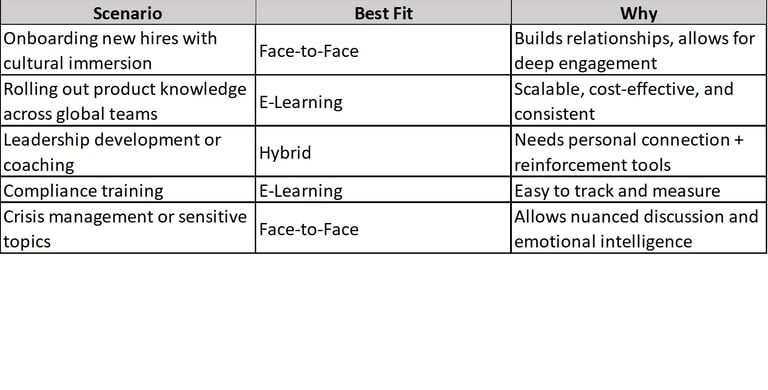Training | Face-to-Face or Online?
Training | Face-to-Face or Online? Which One Works Better?
LEARNING & DEVELOPMENT


Training | Face-to-Face or Online? Which One Works Better?
There was a time when training was only delivered through lectures delivered by a subject matter expert in a class room setting. However, with the evolution and growth of organizations and technological advancement, we now have a number of avenues and tools to impart learning.
Hybrid learning is becoming mainstream now, connecting and training people across dispersed geographical regions across the globe, using various means of training delivery, including virtual class room (instructor led) and e-learning and E-Learning, have opened opportunities for learning and development to a much wider audience.
Both have unique strengths and weaknesses. The best choice depends on the goals, audience, and context.
Let us dive into this interesting debate and form a strategy for optimum Return on Training Investment.
Instructor-Led Face-to-Face Training
💪 Strengths:
Real-Time Interaction: Instant feedback, dynamic discussions, and body language cues enhance communication.
Engagement & Accountability: Physical presence boosts attention and participation.
Team Building: Group activities and in-person interactions foster collaboration and rapport.
Customizable Delivery: Instructors can adapt the pace and examples based on live feedback.
⚠ Weaknesses:
Costly & Logistically Complex: Travel, venues, printed materials, and instructor time increase costs.
Inflexible Scheduling: Learners must attend at specific times and locations.
Scalability Issues: Difficult to deliver consistently across large or geographically dispersed teams.
Retention Risks: Without follow-up, knowledge may fade quickly post-session.
E-Learning (Online/Self-Paced or Virtual Instructor-Led)
💪 Strengths:
Flexible & Convenient: Learn anytime, anywhere—perfect for remote or busy teams.
Scalable & Cost-Effective: Ideal for large organizations or global rollouts with minimal incremental cost.
Consistent Content Delivery: Every learner gets the same message, reducing variability.
Data-Driven Insights: Track learner progress, engagement, and assessment scores easily.
⚠Weaknesses:
Lower Engagement Risk: Without human connection, learners may multitask or lose focus.
Limited Immediate Support: Questions or misunderstandings may go unresolved if not addressed promptly.
Self-Motivation Required: Learners must be disciplined to complete modules.
Tech Barriers: Poor connectivity, lack of devices, or digital literacy gaps can hinder learning.
When to Use What
Conclusion
There’s no one-size-fits-all.
The future lies in blended learning—using the best of both worlds.
Consider audience needs, content complexity, budget, and learning goals when choosing a method.
“Need help designing an impactful training program? Reach out to MindMaps Consulting for a customized training strategy that fits your team’s needs.”


